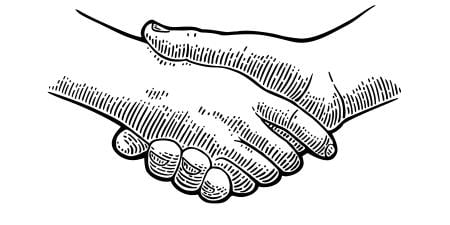Encounters between individuals are as an essential part of medicine as they are of life. The cases in this issue of Virtual Mentor describe challenging encounters in clinical medicine, and their commentaries share an emphasis on the importance of communication between a patient and physician. The articles that fill out the issue explain the importance of the patient-physician relationship and the factors that are shaping it, examine connections between poor communication and risk of litigation, recount an unlikely situation in which a relationship between a “frequent flyer” and physician developed, and introduce a program designed to help medical students build relationships with patients. Patient-physician relationships, as well as encounters between professionals, are often difficult, complicated by both internal and external factors. Yet there are ways that we, as physicians, residents, and medical students, can improve our ability to develop and nurture these relationships.
In the first case, a web-savvy patient researches his symptoms and treatment options on the Internet and relays what he thinks his treatment should be to the physician. David Anthony describes how the rise of accessible medical web resources has slightly changed the patient-physician balance of information in a way some physicians view as a challenge to their authority and expertise. But, he suggests, physicians can use the knowledge of their patients to improve patient care and develop patient-centered relationships that further enhance shared decision making. He also challenges physicians to become familiar with trustworthy web resources so they can guide their patients to reliable online sources.
The physician in case two is contemplating whether or not to offer participation in a phase I trial to the parents of a teenager who has aggressive terminal cancer. Thomas W. LeBlanc and Philip M. Rosoff explain how the mere offer of trial participation can create a therapeutic misconception in the patient and his parents—to the extent that they believe the trial has a real chance of providing therapeutic benefit, when in reality the chance of benefit is virtually nonexistent. The commentators examine the physician’s duty to act in the patient’s best interest versus his or her duty to inform patients of all options and the broader topic of the importance of phase I oncology trials for the advancement of medicine. In their commentary, Courtenay R. Bruce and Anne Lederman Flamm focus on the duty of physicians to inform patients and allow for autonomous decisions. While they acknowledge the reality of the therapeutic misconception, they argue that full disclosure in the informed-consent process provides patients (and parents, in this case) with the information they need to make a decision, thereby respecting their autonomy. They also discuss the concept of assent in situations in which the patient is not legally competent to give consent.
The third case presents a mother who takes her 4-year-old daughter to several pediatricians, and ultimately settles on one who is willing to prescribe antibiotics for her daughter. The case also includes a disagreement between two physicians in the same office over the child’s treatment. D. Micah Hester views the case as a series of missed opportunities for good communication, not only between the physician and the parent, but also between the two physicians who treat the child. Benjamin Levi speaks to miscommunication in the scenario, but also comments on problematic aspects of the second physician’s clinical judgment in prescribing treatment that was not medically indicated.
In the clinical pearl, Natalie A. Brooks outlines management strategies for type 2 diabetes, the chronic condition that is the basis for the first clinical case. She emphasizes that treatment decisions must be tailored to individual patients.
One question that is central to this issue is whether or not a good patient-physician relationship even matters. In the journal discussion, Scott B. Grant addresses the questions not only of whether or not the patient-physician relationship is important, but what factors improve or stress it. He explains and critiques two models that the journal article authors propose as blueprints for a good relationship.
Kelly Dineen tells a compelling story in the policy forum of the importance of professional caregivers’ adherence to their scope of practice. In the new model of comprehensive patient care, physicians alone cannot meet the full range of the patients’ medical and health-promotion needs, and because of this, physician assistants and advanced practice registered nurses are included in health care delivery. She identifies physicians’ responsibilities for overseeing and collaborating with them.
In the medicine and society article, Howard A. Brody describes two forces that are shaping the patient-physician relationship: the medical home and pay-for-performance. He argues that, while the idea of the medical home threatens the one-on-one nature of the traditional patient-physician relationship, it broadens and enhances the relationship in ways that are, on balance, more significant. On the other hand, he believes that pay-for-performance will not improve relationships between patients and physicians and recommends approaching this concept with wariness. As technology progresses, physicians have the ability to treat patients more competently. These advances do not necessarily have to replace the relationships between patients and physicians that are the core of medical practice.
At a time when many physicians are lamenting changes in medicine that have significantly diminished their ability to develop relationships with patients (e.g., increased amounts of paperwork, shorter office visits), Chris Brooks relates the story of patient-physician relationships in an unlikely setting—the emergency room. He describes a “frequent flyer” patient who visited the emergency room on an almost daily basis and developed relationships with staff members that allowed them to care for him more compassionately and in a resource-conscious way.
As medicine has become more technical, medical education has increasingly focused on the knowledge of disease processes, often squeezing out time for considering the important relationships between patients and physicians. In light of this, some medical schools have attempted to renew the emphasis on relationships in medicine. Arno K. Kumagai discusses the 2-year Family Centered Experience at the University of Michigan, which pairs medical students with community members who have chronic or serious diseases. He describes the goals, benefits, and challenges of this program.
Kristin E. Schleiter, in the health law piece, explores the subject of medical malpractice litigation. According to documented studies, patients who have good relationships with their physicians are less likely to file complaints in the event of an adverse medical outcome.
Relationships in medicine are as important now as they were in the past. Today’s technology allows physicians to do much more to treat diseases, but this enhanced ability need not replace physicians’ communication and ability to empathize with patients. In other words, the ability to treat the disease must not undermine the ability to treat the patient with the disease. As the articles in this issue demonstrate, relationships are still, and will continue to be, an essential element of medicine. With so many factors competing for the physician’s time and energy, we must not lose sight of the importance of communication, empathy, and knowledge of the patient as a person.



